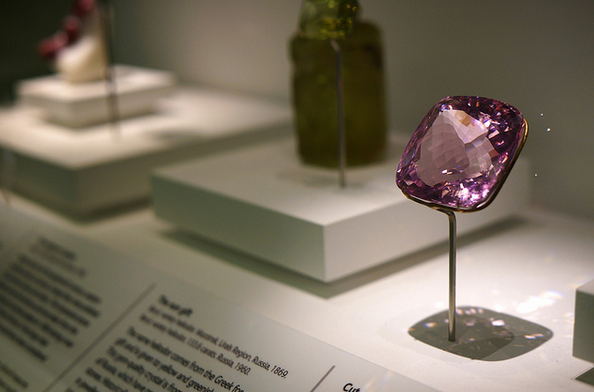MOTHER'S DAY SALE! Up To 50% OFF & 15% OFF Code: MOM15 + Free Shipping |Track My Order
The Origins Of A Gemstone's Name
This gorgeous cut morganite, a stone that's named after financier and gem collector J.P. Morgan, is on display in the British National History Museum.
Discovery Location
Many gemstones are named after locations. For instance, topaz was named after a tiny island in the Red Sea that was called Topazos. There is a region in Canada that is called Labrador, and the labradorite is named after it. Tanzanite was first discovered in Tanzania, and out of the Tsavo National Park came the tsavorite, found by Campbell Bridges, a gemologist in the later part of the 1960s. Andalusia is the original location where the andalusite was found, so the stone was named after that area in Spain.
Language Origins
Gemstones are often named after words from other languages. There are many gemstones named after Latin or Greek root words. For instance, rhodolite is derived from the Greek word for "rose." Rhodolite is a pink gemstone. In the Greek language, a bright green herb, mallow, gave its name to malachite. Malachite is a bright green gemstone with lighter green bands running through it. The Greek word for blue is kyanos, and kyanite is a beautiful blue gemstone.
Discoverers
Some gemstones are named after the person who discovered them. The stone originally called saualpite, named after the place in which it was found, the Saualpe Mountains, in the early 1800s, had a name change to become zoisite. A scientist from Slovenia named Baron Sigmund Zois von Edelstein first realized that it was a mineral that was unknown at that time, so the stone was named after him. Colonel Hendrik von Prehn found a beautiful green stone, which eventually was named prehnite. W.E. Hidden found a stone very similar to the emerald in North Carolina in the late 1800s, and because he discovered it, it was named hiddenite.
In Honor of Someone
It would definitely be exciting to find a new type of mineral or gemstone, but how exciting would it be if you hadn't found it, but it was named after you? There are many examples of gemstones that were discovered and then named after someone in order to honor them. Famous financier J.P. Morgan had a gemstone named after him. The morganite is pink beryl but was renamed in order to honor this rich gem collector. Like I mentioned earlier, Alexander II, the Russian tzar, had the alexandrite named after him. The stone was actually discovered in the Ural Mountains in the early 1800s in an emerald mine. It was also the national stone of his nation during that time period. And the pink spodumene was renamed kunzite after George F. Kunz, a famous gemologist.
Descriptive Names
There are also many gemstones that are given names that simply describe the stone. The moonstone was named because of the way the light gently flows across the stone. It has almost a moon-like effect. The aquamarine has a greenish-blue tint that seems to look a bit like crystal-clear water. "Aqua" is the Latin word for water. The fire opal is an opal that has a fire-like hue, using the light to make it appear to glow.
No Special Names
While it is interesting to learn the origin of a gemstone's name, there are several beautiful and highly popular gemstones that don't have special names. For instance, ruby is the name for the type of corundum that is red (it derives from a Latin word that means red). Other types of corundum are just called by their color. Blue sapphire, white sapphire, pink sapphire and yellow sapphire are all beautiful stones that each are featured in beautiful jewelry but weren't given special names like their sister stone the ruby.

